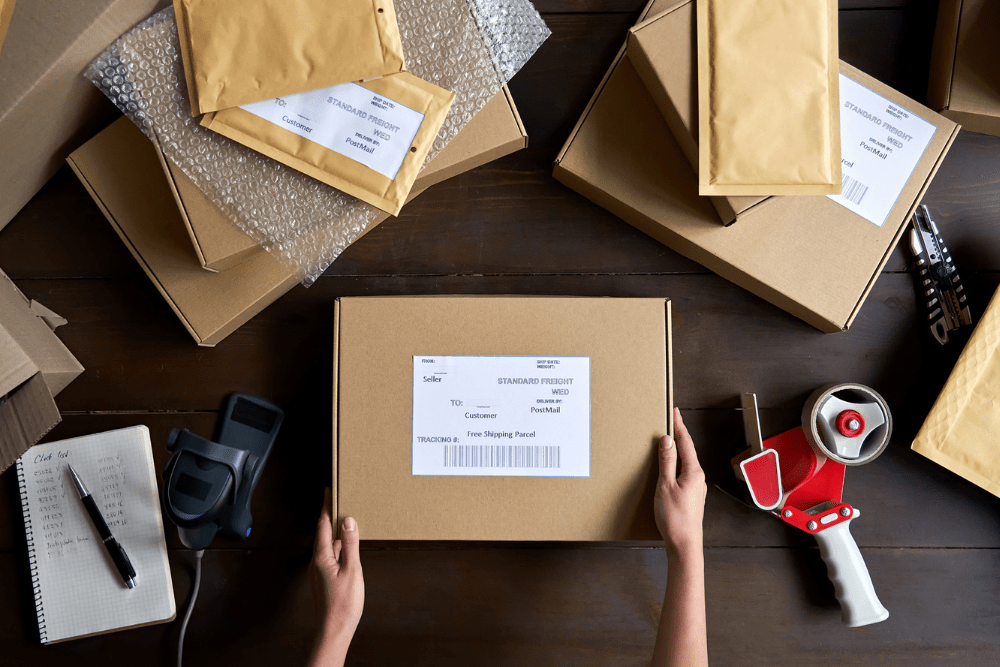Thinking about getting an office postage meter for your San Francisco business but don’t know where to start?
This article will tell you everything you need to know about office postage meters. We will tell you what they are, the features you need in your office postage meter, and why your San Francisco business needs one in-house.
What Is An In-House Office Postage Meter?
Office postage meters in one form or another have been around since the Gold Rush of 1849. The first postage stamp affixing machine came along in the 1880s. The U.S. Post Office didn’t get around to approving the first in-house office postage meter until 1923, but that still means that these handy devices have been with us for almost a century.
The first postage meters had manual cranks to print a dye on envelopes. Each crank recorded the expense of mailing one letter, and from time to time, companies would take their meters into the nearest post office to pay up.
Modern office postage meters come in various guises, including postage machines, stamp machines, mailing machines, franking machines, postage printers, mail meters, and so on. Every office postage meter does the same job, calculating postage rates and applying postage.
You can’t buy an office postage meter outright. U.S. Postal Service regulations require that private businesses rent or lease their machines from authorized dealers. You will usually lease an office postage meter for one to five years. The longer the lease term, the lower your monthly fee.
If you send more than a few pieces of mail every month, the chances are that you will save money by leasing an in-house postage meter.
Postage meters are a lot faster than licking stamps. They can usually seal envelopes, too. Your postage meter will print the exact amount of postage needed to send your mail, no more and no less. You will never have to go to the post office to buy stamps, and your meter can be programmed to print your logo.
Other benefits of using an in-house office postage meter include:
- An automatic one-percent discount on postage. That may not sound like much, but year after year, it adds up.
- Increased productivity. Think of all the time your employees can save by never having to stand in line at the post office again.
- Easy bulk mailings for marketing campaigns. Bulk mailings are a great way for a new business to gain visibility. With your own postage meter, you won’t have to waste employee hours on affixing stamps—and your mail will have a much more professional look.
- More straightforward billing and invoices. You can send and pay your bills much more easily with a postage meter.
- Easy access to every service the U.S. Postal Service offers. You can take advantage of their offers and make savings on Priority Mail and Express Mail.
What Features Are Included In An Office Postage Meter?
Office postage meters aren’t manufactured to the same specifications. You need to make sure any meter you lease has certain basic features.
You’ll need to choose between manual, semi-automatic, and automatic postage meters. If you don’t send a lot of mail and are primarily interested in not making multiple post office visits, a manual postage meter may suffice. With this machine, you insert and remove envelopes by hand.
If you have a low to medium volume of outgoing mail, consider a semi-automatic office postage meter. This machine grabs and prints one envelope at a time.
And if you do mass mailing, you will definitely need an automatic office postage meter. This device grabs envelopes and prints in batches.
Some office postage meters moisten and seal envelopes. The more mail you handle, the more useful this feature will be.
You need to consider speed. The minimum speed is about 17 envelopes a minute. You also need to consider ease of use (touchscreen or buttons), jam-free operation time, the ease of selecting the type of postage you want to print (first-class or bulk), and input and output tray capacities.
Don’t forget to ask about your scales. You will need a scale that measures the heaviest items you ship, automatically calculating the correct postage. Most scales accommodate just 2 to 15 pounds, but your meter can be configured to work with an external scale that weighs parcels and packages up to 70 pounds.
Dynamic weighing measures each piece of mail individually and calculates the exact amount of postage needed, but differential weighing only measures the change in weight as each piece is removed from the stack. Dynamic weighing is more accurate.
Does My San Francisco Business Need One In-House?
Do you lose a lot of employee hours on trips to the post office? Do you spend enough money on postage that you would notice a one-percent reduction in your mailing costs? Are you planning a direct mail campaign? Do you want to use outgoing mail as part of your branding or advertising campaign?
If your answer to any of these questions is yes, your San Francisco Bay Area business may benefit from an in-house office postage meter. Call Golden Gate Office Solutions today, and we´ll go over your options.

